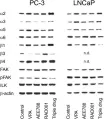Endothelial cells lining the blood vessel wall communicate intricately with the surrounding extracellular matrix, translating mechanical cues into biochemical signals. Moreover, vessels require the capability to enzymatically degrade the matrix surrounding them, to facilitate vascular expansion. c-Src plays a key role in blood vessel growth, with its loss in the endothelium reducing vessel sprouting and focal adhesion signalling. Here, we show that constitutive activation of c-Src in endothelial cells results in rapid vascular expansion, operating independently of growth factor stimulation or fluid shear stress forces. This is driven by an increase in focal adhesion signalling and size, with enhancement of localised secretion of matrix metalloproteinases responsible for extracellular matrix remodelling. Inhibition of matrix metalloproteinase activity results in a robust rescue of the vascular expansion elicited by heightened c-Src activity. This supports the premise that moderating focal adhesion-related events and matrix degradation can counteract abnormal vascular expansion, with implications for pathologies driven by unusual vascular morphologies.
© 2024. Published by The Company of Biologists Ltd.
Product Citations: 29
c-Src-induced vascular malformations require localised matrix degradation at focal adhesions.
In Journal of Cell Science on 1 July 2024 by Essebier, P., Keyser, M. S., et al.
-
ICC
-
WB
-
Homo sapiens (Human)
-
Cell Biology
In IScience on 20 October 2023 by Guo, Z., Ma, Y., et al.
Streptococcus agalactiae (S. agalactiae) is a contagious obligate parasite of the udder in dairy cows. Here, we examined S. agalactiae-host interactions in bovine mammary epithelial cells (BMECs) in vitro. We found that S. agalactiae infected BMECs through laminin β2 and integrin. Crk, Vps25, and RhoA were differentially expressed in S. agalactiae-infected cells. S. agalactiae infection activated FAK and Crk. FAK deficiency decreased the number of intracellular S. agalactiae and Crk activation. Knockdown of Crk or Vps25 increased the level of intracellular S. agalactiae, whereas its overexpression had the opposite effect. RhoA expression and actin cytoskeleton were altered in S. agalactiae-infected BMECs. Crk and Vps25 interact in cells, and invaded S. agalactiae also activates Crk, allowing it to cooperate with Vps25 to defend against intracellular infection by S. agalactiae. This study provides insights into the mechanism by which intracellular infection by S. agalactiae is regulated in BMECs.
© 2023 The Author(s).
-
Veterinary Research
c-Src induced vascular malformations require localised matrix degradation at focal adhesions
Preprint on BioRxiv : the Preprint Server for Biology on 15 September 2023 by Essebier, P., Schimmel, L., et al.
Endothelial cells lining the blood vessel wall communicate intricately with the surrounding extracellular matrix, translating mechanical cues into biochemical signals. Moreover, vessels require the capability to enzymatically degrade the matrix surrounding them, to facilitate vascular expansion. c-Src plays a key role in blood vessel growth, with its loss in the endothelium reducing vessel sprouting and focal adhesion signalling. Here, we show that constitutive activation of c-Src in endothelial cells results in rapid vascular expansion, operating independently of growth factor stimulation or fluid shear stress forces. This is driven by an increase in focal adhesion signalling and size, with enhancement of localised secretion of matrix metalloproteinases responsible for extracellular matrix remodelling. Inhibition of matrix metalloproteinase activity results in a robust rescue of the vascular expansion elicited by heightened c-Src activity. This supports the premise that moderating focal adhesion-related events and matrix degradation can counteract abnormal vascular expansion, with implications for pathologies driven by unusual vascular morphologies.
-
ICC
-
WB
-
Homo sapiens (Human)
αvβ3 Integrin induces partial EMT independent of TGF-β signaling.
In Communications Biology on 21 April 2021 by Kariya, Y., Oyama, M., et al.
Epithelial-mesenchymal transition (EMT) plays a pivotal role for tumor progression. Recent studies have revealed the existence of distinct intermediate states in EMT (partial EMT); however, the mechanisms underlying partial EMT are not fully understood. Here, we demonstrate that αvβ3 integrin induces partial EMT, which is characterized by acquiring mesenchymal phenotypes while retaining epithelial markers. We found αvβ3 integrin to be associated with poor survival in patients with lung adenocarcinoma. Moreover, αvβ3 integrin-induced partial EMT promoted migration, invasion, tumorigenesis, stemness, and metastasis of lung cancer cells in a TGF-β-independent fashion. Additionally, TGF-β1 promoted EMT progression synergistically with αvβ3 integrin, while a TGF-β signaling inhibitor showed no effect on αvβ3 integrin-induced partial EMT. Meanwhile, the microRNA-200 family abolished the αvβ3 integrin-induced partial EMT by suppressing αvβ3 integrin cell surface expression. These findings indicate that αvβ3 integrin is a key inducer of partial EMT, and highlight a new mechanism for cancer progression.
-
WB
In Scientific Reports on 10 March 2021 by Eidson, L. N., Gao, Q., et al.
Stroke is a multiphasic process involving a direct ischemic brain injury which is then exacerbated by the influx of immune cells into the brain tissue. Activation of brain endothelial cells leads to the expression of adhesion molecules such vascular cell adhesion molecule 1 (VCAM-1) on endothelial cells, further increasing leukocyte recruitment. Polymerase δ-interacting protein 2 (Poldip2) promotes brain vascular inflammation and leukocyte recruitment via unknown mechanisms. This study aimed to define the role of Poldip2 in mediating vascular inflammation and leukocyte recruitment following cerebral ischemia. Cerebral ischemia was induced in Poldip2+/+ and Poldip2+/- mice and brains were isolated and processed for flow cytometry or RT-PCR. Cultured rat brain microvascular endothelial cells were used to investigate the effect of Poldip2 depletion on focal adhesion kinase (FAK)-mediated VCAM-1 induction. Poldip2 depletion in vivo attenuated the infiltration of myeloid cells, inflammatory monocytes/macrophages and decreased the induction of adhesion molecules. Focusing on VCAM-1, we demonstrated mechanistically that FAK activation was a critical intermediary in Poldip2-mediated VCAM-1 induction. In conclusion, Poldip2 is an important mediator of endothelial dysfunction and leukocyte recruitment. Thus, Poldip2 could be a therapeutic target to improve morbidity following ischemic stroke.
-
WB
In BMC Cancer on 25 August 2011 by Wedel, S., Hudak, L., et al.
Fig.6.A

-
WB
-
Homo sapiens (Human)
Collected and cropped from BMC Cancer by CiteAb, provided under a CC-BY license
Image 1 of 1
